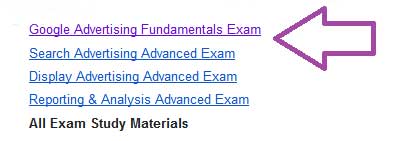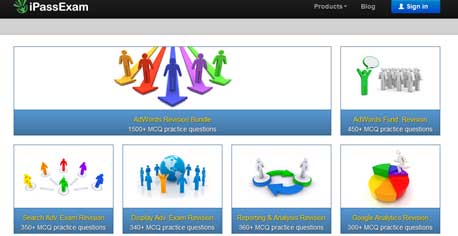When I look back to the time I took the AdWords Fundamentals Exam for the first time, I have to admit I was stressed for days, if not weeks. I’m sure you are reading this article because you too must be wondering, “What if I fail it? – it’s 113 Questions!”.
But, even if you are fairly new to the PPC World, it is possible to nail it the very first time you take the test. Below, I have included 5 tips that will guarantee you pass the test successfully.
1. Use the Google AdWords Learning Center
The material in the AdWords Learning Center was created exactly for the purpose of helping Google Certification Exam takers pass the test. It is a complete guide that shows you everything that will be covered in each test. And it is divided into topics!
One tip to reading this material effectively is to read only one or two sections per day. This of course so you don’t get overloaded with information.
Also, make sure you re-read or take notes of any sections you found difficult (especially if you are very new to the industry).
Besides, you don’t need to read the whole thing – just choose the sections relevant to the test you are taking. I read the 4 sections in their entirety when I only had a couple of months working at White Shark Media. I have to confess, had I known about those great links initially, I wouldn’t have tweaked my study strategy so.

Although, if you are an avid reader, going through the Search Advertising Advanced Exam section will reinforce your knowledge and give you some extra insight you can very much apply in your day to day tasks.
2. Use the iPassExam – Very Helpful for Beginners
iPassExam includes a large bundle of over 1,000 questions from which around 400 relate to the Fundamentals Exam.
These questions are similar in format and style to the ones on the official Google AdWords Fundamentals Test. So, if you are not into reading so much and don’t mind making a small investment, this is a great deal.
Wondering why should you spend money on this tool if you have already read the Learning Center material and/or watched some videos?
Well, in the Fundamentals Exam, you will be able to mark the answers you are unsure of for later review. Nonetheless, the wording sometimes can be puzzling and make you consider incorrect choices. Not to mention that many questions have more than one right answer. This meaning of course that you need to choose the “best” answer. By taking the iPass Practice Test, you’ll be able to identify some of that “tricky wording” or “best answers in XYZ scenario” and avoid getting marked down on something you do understand and currently apply.
Additionally, this tool will show you the right answers whenever you mark the wrong one. So, therefore, you can focus on studying whichever area you find less familiar, learn something new or refresh your memory.

Sometimes, the material may be a bit outdated but overall, it has up-to-date information. I would recommend taking the iPass only after having thoroughly reviewed Google’s Learning Center. But if you don’t have much time to go through some serious reading, then this is a good alternative.
There are other paid options available for “mock tests” and study guides such as http://www.ucertify.com/exams/Google/adwords-fundamentals.html but the investment is higher than $120 so I would stick to iPassExam which is a more affordable option and quite reliable as well.
3. Use your Common Sense and Experience. But Ultimately When in Doubt… Think Like Google
As in any given day as an AdWords Consultant, you will have scenarios in which you could take different approaches to solve an issue or improve performance – and there will be more than 1 right answer. But you’re expected to choose the “best” answer for each scenario presented.
At this point, you may feel tempted to choose an approach that you know works better for improving results than what’s recommended by Google. But keep in mind you are getting “Google Certified”, so stick to the best answer according to Google’s Learning Center.
4. Get Ready Ahead of Time
No matter which combination of tools you decide to use, start getting ready for the test at least 2-3 weeks prior to taking it. That way, you’ll have enough time to review anything you’re having doubts about without affecting your regular workday or sleeping patterns.
I recall that despite having been quite stressed the night before, I didn’t need to pull those infamous college all-nighters or cram a humongous amount of information all at once days before. This made my test-taking experience much more pleasant. Hope your experience goes smoothly as well!
5. Facts About the Test:
-
- The test is 100% multiple choice
-
- It totals 113 questions
-
- You have 2 hours to complete it and once the timer starts ticking, you can’t pause it so make sure you go to the restroom or make that phone call prior to you start!
-
- Required passing grade: 85%
-
- Costs $50.00 each time you take it
-
- You will get a Candidate ID Number (Make a good note of it. This will be your ID for the Advanced Test, as well).
Thanks for watching, see you next time!
Video Transcription
Today we’re gonna be talking about the Google Search Algorithm, and specifically how the algorithm is updated often to make sure that users are always provided with the most relevant results possible.
It’s worth noting that these search engine algorithm updates occur more than 600 times a year. That’s more than twice a day. So stay tuned to find out about the most important updates in Google history and how those updates affect your website.
1) The Panda Update
In 2011, the Panda update was rolled out by Google in an attempt to limit poor quality websites making it to the top search results.
Since its full rollout at the end of April 2011, the Google Panda update has been experiencing a progressive and continual string of updates.
If you want to make sure that your website is complying with Google’s policies, check out the Google Webmaster blog and Google Webmaster Guidelines for more guidance on how to build high-quality sites.
2) The Penguin Update
The second biggest update in Google’s algorithm history came in April 2012 with the release of the Penguin.
The Penguin update’s biggest aim was to decrease search engine rankings for websites that artificially increase the number of links pointing to a specific page within the site a.k.a. black hat SEO.
So don’t get caught up trying to get as many links as you can no matter where they’re from. Since Penguin, it’s way more important to focus on developing high-quality content and earn those links.
3) The Hummingbird Algorithm
The next biggest update came in 2013 with the release of the Hummingbird algorithm, an update that focuses on the user’s intent when performing a search rather than the keywords.
Danny Sullivan the founder of Search Engine Land had the following things to say about the Hummingbird algorithm. “Hummingbird is paying more attention to each word in a query, ensuring that the whole query — the whole sentence or conversation or meaning — is taken into account.”
4) Mobilegeddon
The last update we wanted to discuss with you today is also the most recent.
By now you’ve probably heard people talking about something called Mobilegeddon, which is actually a reference to Google’s first mobile-friendly ranking algorithm update.
The purpose of Google’s latest algorithm update is actually designed to reward mobile-friendly websites with greater exposure to the search engine results pages.
The best way to combat any backlash from the algorithm is to make sure your website is mobile-ready and responsive.
If you want to learn more about how to implement SEO best practices or follow Google’s Webmaster Guidelines, stay tuned for more tricks and techniques from our blog.
See you next time!






